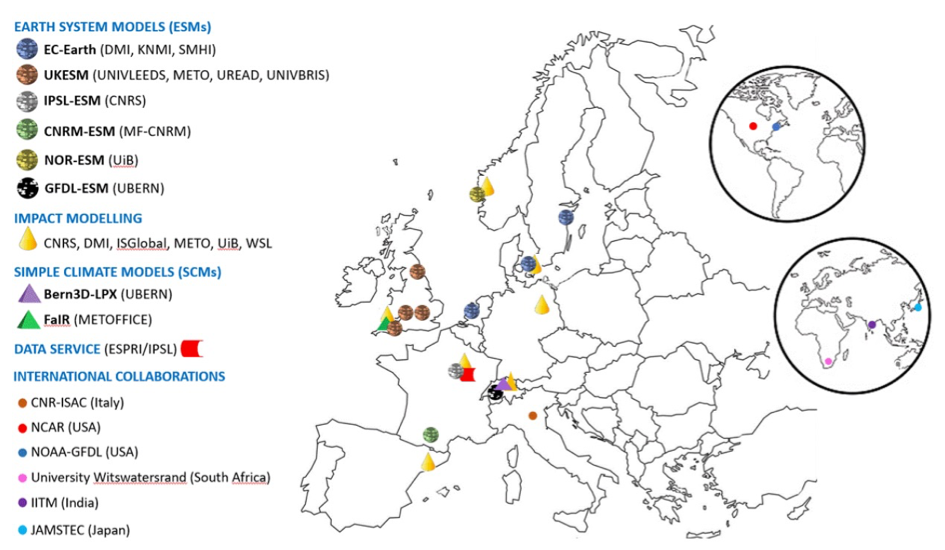C2SM Newsletter vol. 37

Topics in this Newsletter – September 2023
- News from the Steering Committee
- Modelling Activities and Services
- C2SM Technical Trainings
- News from EXCLAIM
- News from the C2SM Community
- Upcoming Events
- PhD Defenses
- Selected Press Articles
Highlighted papers in the C2SM Community
- Warm Conveyor Belts in Present-Day and Future Climate Simulations
- The Pseudo-Global-Warming (PGW) Approach: Methodology, Software Package PGW4ERA5 v1.1, Validation and Sensitivity Analyses
- Jet Stream Dynamics from a Potential Vorticity Gradient Perspective: The Method and its Application to a Kilometre-Scale Simulation
- Daily 1 KM Meteorological Forcing Data for Climate Impact Studies
- On the Statistical Distribution of Temperature and the Classification of Extreme Events Considering Season and Climate Change – an Application in Switzerland
News from the Steering Committee
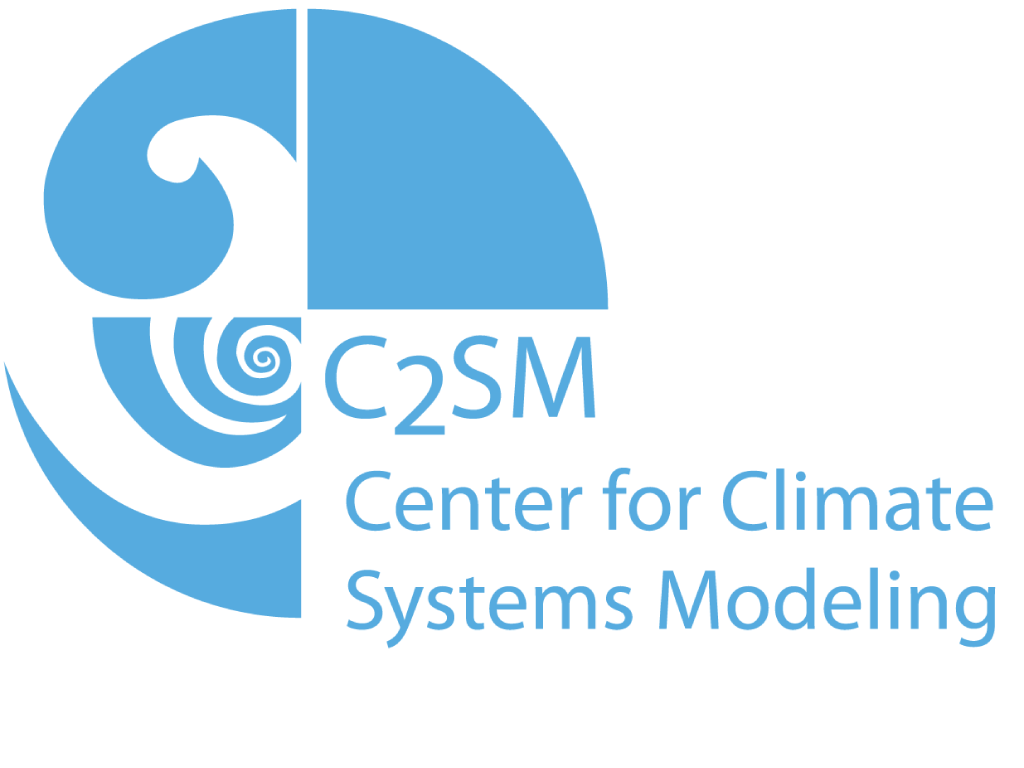
Swiss Climate Summer School 2023 successfully concluded
Since 2002, the Swiss climate research community has been committed to sustained education of young researchers in its field, and to ensure a long-term investment in the future generation of young competitive climate researchers. The Swiss Climate Summer School is jointly organised by C2SM and the external pageOeschger Centre for Climate Change Researchcall_made (OCCR, based at the University of Bern) on an annual basis.
This year's school, the 21st Swiss Climate Summer School, took place at Monte Verità in Ascona, Switzerland, from 3 - 8 September 2023 and focused on the topic of the "Climate-Water-Energy-Food-Nexus". In this highly interdisciplinary school aimed at early stage researchers, the topic of climate change was bridged with sustainable development goals strongly focusing on social, economic, and humanity aspects.
68 participants were offered a comprehensive program that included 12 keynotes lectures given by high-profile national and international lecturers, four workshops, poster sessions, and a concluding round table.
More details on the school can be found in this C2SM news article.
external pagewww.climateresearch.chcall_made
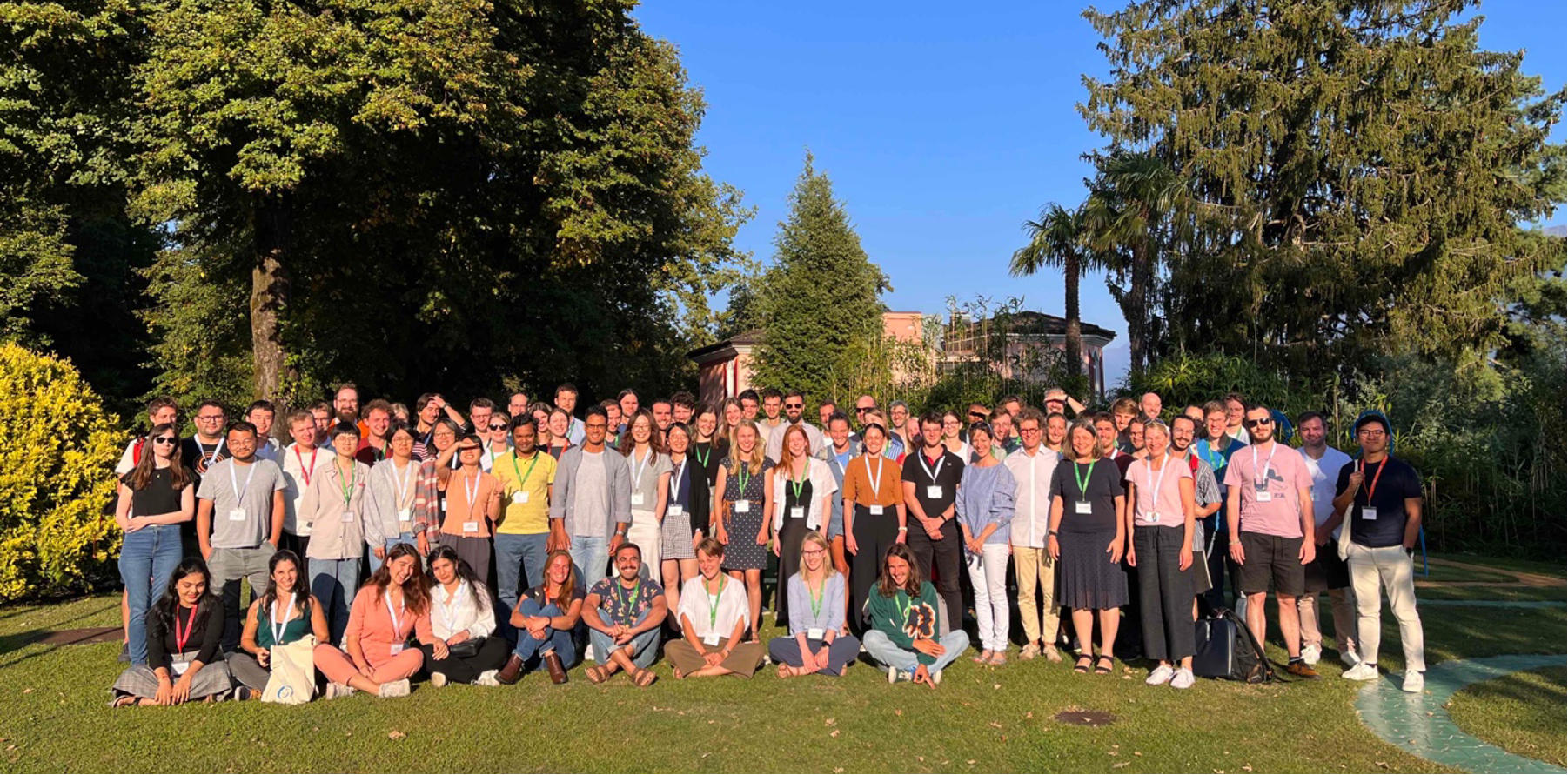
Klima CH2025 update
The tradition of developing climate change scenarios for Switzerland started about two decades ago. After reports in 2007 and 2011, the latest climate scenario report, the Swiss climate change scenarios CH2018, presents the actual projections of how climate changes in Switzerland. In March 2023 a new project has been kicked off to develop the next generation of climate information to be published by 2025, the Klima CH2025 project. Since March-July 2023, all CH2025 working groups have now met with the project coordinators at ETH Zurich and MeteoSwiss, i.e. Laura Booth at ETH Zurich and Regula Mülchi at MeteoSwiss, and have taken steps to consolidate their groups, identify working group goals and kick off work streams. Two working groups primarily focus on elaborating the science that the report will be based upon. In addition, there are working groups around data infrastructure, communication, and product innovation and co-design. Whereas most work currently focuses on science, alongside, work is also underway in early project logo design and branding, setting up of a website and engaging with media and events teams in both institutions. Decisions required by the individual working groups will be approved by the Steering Group, which consists of the lead persons from both MeteoSwiss and ETH Zurich, and which will meet 3-4 times per year. A first Steering Group meeting took place on 18 September 2023.
Modelling Activities and Services
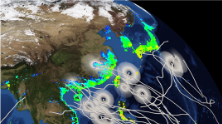
ICON-C
As part of the EXCLAIM project, C2SM is contributing to a joint effort of the external pageICON climate modelcall_made community called ICON-C (ICON Consolidated), which aims to make the ICON code more modular. The first step involved taking a high number of utility-functions out of ICON. These functions mainly make standard C and C++ code acessible from Fortran and are now gathered in a new library called libfortran-support. This was accompanied by adding thorough tests to check the code at the level of individual functions. This first version of libfortran-support has been added to ICON recently and is available for the entire ICON-community.
Working Group 1 (WG 1): High Performance Computing
Finalising the GPU port of hailcast for ICON
The GPU-accelerated variant of the Hailcast model, a diagnostic to estimate expected hailsize, has been integrated into ICON from the COSMO model, thanks to a dedicated effort during a master’s thesis supervised by MeteoSwiss. Although challenges arose during testing that prevented immediate upstream merging of the code, significant progress towards a correct and fully GPU-capable diagnostic was made during that thesis. The remaining issues, addressed by the C2SM core staff, including refining the reset intervals and fixing a bug to ensure successful testing, were part of this task. It is worth noting that the comprehensive and functional hailcast module is on the verge of being deployed for operational use by MeteoSwiss in the near future.
Working Group 2 (WG 2): Development of Weather and Climate Models
Setting up continuous integration for FLEXPART-COSMO
The Lagrangian particle dispersion model external pageFLEXPART-COSMOcall_made allows the simulation of atmospheric trace gas transport. The model is currently used at Empa for estimation of greenhouse gas emissions and at MeteoSwiss for nuclear safety preparedness.
The model development process is being enhanced as two test case have been established. At Empa, FLEXPART-COSMO is intensively used for tracer backward simulations from the greenhouse gas observing networks in Switzerland and Europe. At MeteoSwiss, the model is applied for radioactive tracer forward simulations to improve emergency preparedness in the context of the safety of nuclear power production. With the support of C2SM and as part of this task, the integration of these test cases into our automated build system (Jenkins) ensures rigorous and reliable continuous development practices.
Although expecting identical results from two FLEXPART simulations with identical setups and inputs, even minor code adjustments could lead to variations in results due to the chaotic behaviour of turbulent airflow patterns. To address this issue, the integration of an objective verification method into the test framework has just been finished as the final step of this task.
Updating and consolidating the processing chain for ICON-ART
The Processing Chain is a collection of Python scripts to prepare the input data, submit the compute jobs to the HPC system at CSCS (Swiss National Supercomputing Centre), and to apply post-processing steps for COSMO and ICON simulations. Recently, Empa has expanded the capabilities of the Processing Chain to promote global simulations with the external pageICON-ARTcall_made (Aerosolos and Reactive Trace Gases) model and to make simulations with ICON-ART usable in conjunction with CTDAS (CarbonTracker Data Assimilation Shell), an extendible data assimilation framework for the global CO2 model CarbonTracker. While this expansion is promising, it has led to complexity in certain areas of the Processing Chain source code that requires extensive restructuring for clarity and accessibility.
The task at hand is to integrate recent enhancements into the main code base at C2SM and revise the structure to ensure comprehensibility. This restructuring has the potential to not only ease the onboarding of new users, but also simplify the integration of new options and configurations.
The treatment of global ICON-ART simulations has already been integrated into the main version of Processing Chain. In parallel, the refactoring work is well advanced and will be finished within the next weeks. Enabling Processing Chain for ICON-ART-CTDAS simulations is another effort that will be integrated once the refactoring is complete.
COSMO-CLM²
COSMO-CLM², the coupled version of the external pageCOSMO-CLMcall_made regional climate model and the external pageNCAR CESMcall_made Commuity Land Model (CLM) through the OASIS coupler, was ported to COSMO-6 and CLM-5. A major effort was required to compile CLM on Piz Daint. For this, the CLM-OASIS interface had to be completely rewritten, while the COSMO side was already implemented and waiting for testing. The resulting COSMO-CLM² model fully leverages Piz Daint’s power: On each node, the COSMO part uses one CPU and the GPU device while CLM uses the remaining 11 CPUs. The workflow tool of the HyMet group dedicated to long-term COSMO simulations, DECREMENT, has been adapted to enable long-term simulations including pre- and post-processing and restarts.
Working Group 3 (WG 3): Climate Scenarios
ICON-CLM in CORDEX setup
One of the use cases of the EXCLAIM project are regional climate simulations (RCMs) over Europe using the GPU version of external pageICON-CLMcall_made. In this context, CLM stands for Climate Limited-area Modeling. These simulations will also contribute to the Klima CH2025 project. A first 10-year test simulation (driven by ERA5 data) with a subsequent evaluation analysis against observational data has been performed. Having demonstrated the ability of the GPU version of ICON to produce reasonable climatology statistics, the next steps are to perform “official” evaluation and historical runs, which are necessary before producing a first scenario simulation.
Working Group 4 (WG 4): Climate Impacts
Available datasets at the servers of the Institute for Atmospheric and Climate Science (IAC) at ETH Zurich and at CSCS are growing. C2SM core staff downloaded and processed large amounts of data from the external pageCopernicus Climate Data Storecall_made during the last few months. We now have a set of variables available from the external pageCERRAcall_made and external pageCERRA-Landcall_made reanalyses datasets and a few variables from external pageERA5call_made and external pageERA5-Landcall_made as daily and monthly aggregates (means, sums, maximum, minima depending on the variable). More details on the datasets can be found at the C2SM wiki page (wiki.c2sm.ethz.ch). We are also preparing a workshop about climate models and climate data where we will introduce how climate models work, what they can and cannot provide, and what kind of output they produce. We also plan a short introduction about observational and reanalysis data, what data we already have at C2SM and examples of other datasets, as well as a short introduction on how to work with this data. This workshop is planned to be held on 6 December 2023 at Eawag Dübendorf.
C2SM Technical Trainings
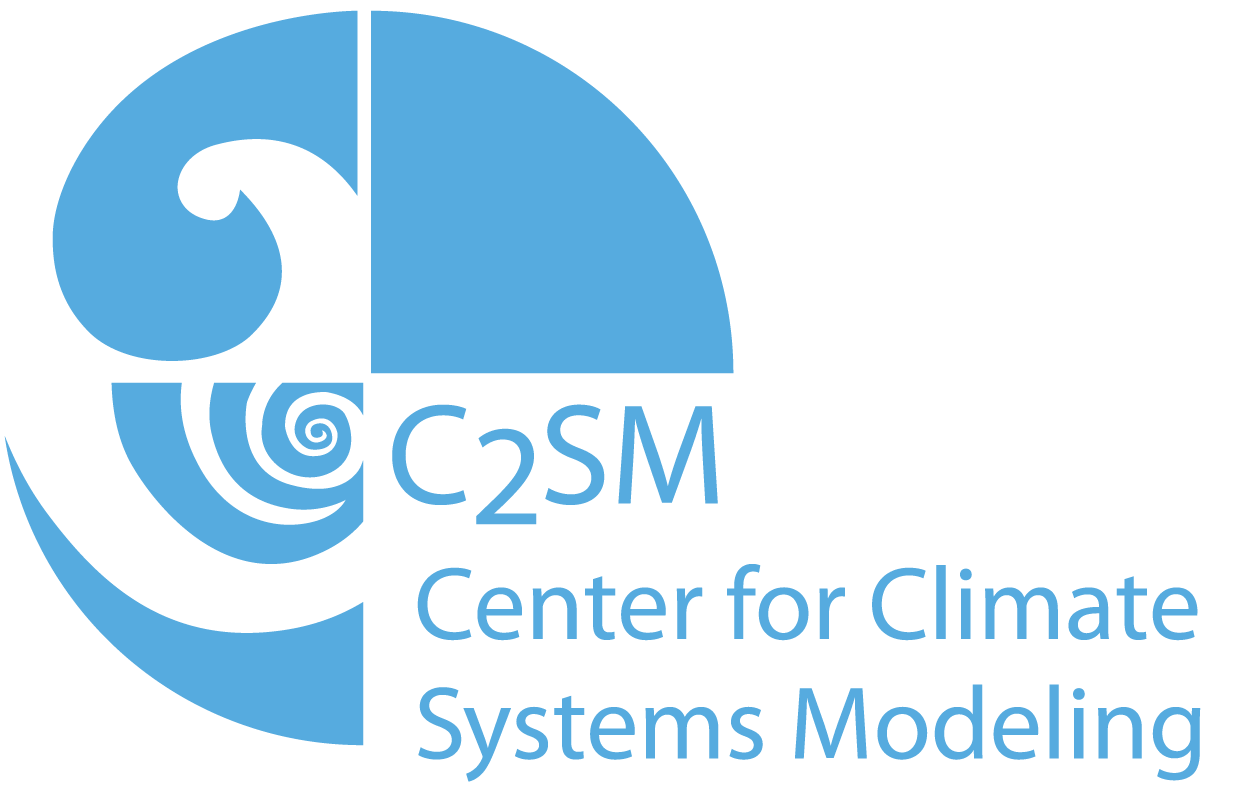
Technical course «Git for beginners» successfully carried out
On 27 April 2023, C2SM core team members Jonas Jucker, Annika Lauber and Michael Jähn held the annual "Git for Beginners" workshop at ETH. There were 17 participants from various member groups of the C2SM community (IAC, IBP, MeteoSwiss, Eawag). The course consisted of slides and hands-on Git exercises using Jupyter Notebooks. All course material is available online so that the exercises can be reworked. Participants gave very positive feedback on the course, which will form the basis of the "Git for Advanced" course in September 2023.
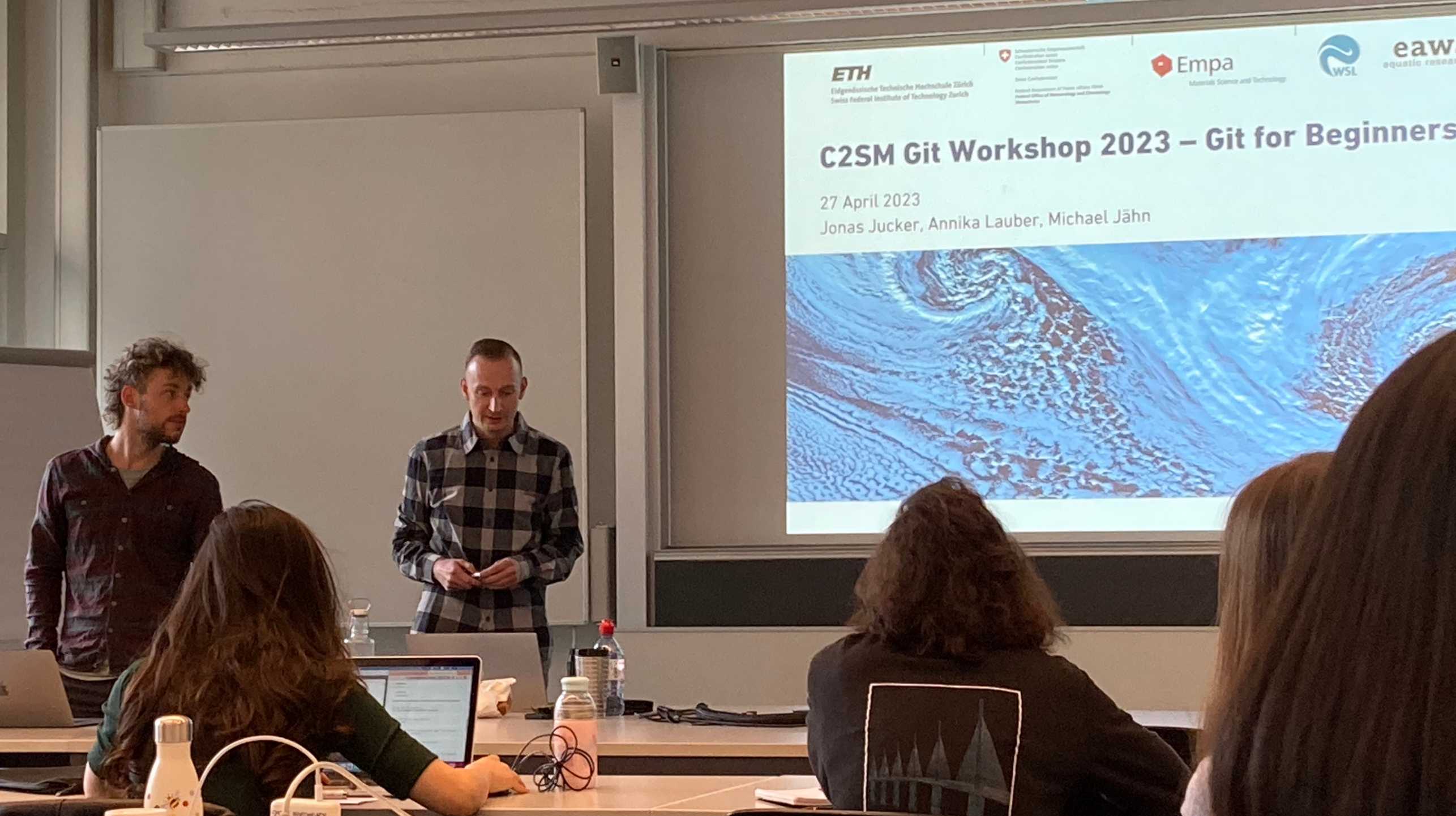
Announcement of Further Courses 2023
- Climate models and climate data workshop
The "Climate Models and Climate Data Workshop" will be given for the first time. The workshop will be tailored to the impacts community and will give an introduction to what a climate model is and how it works. We will cover input, what kind of output it produces and some other things to consider like uncertainties and model independence. In addition, we will give an overview over some observational and reanalysis products we have. We will also explain how to get access to climate model and observational data at C2SM and elsewhere. The workshop will also include a short hands-on session about how to use climate data. We will explain the most common data format NetCDF, how to read this into python and R and show some simple calculations using the Climate Data Operators (CDO). The workshop will take place at Eawag Dübendorf on the 6th of December 2023. Registration will open shortly. - Git for advanced users
September 28, 2023, 9 am – 12:30 pm, HG F33.1
last spots available, please register online
News from EXCLAIM

The EXCLAIM project (Extreme scale computing and data platform for cloud-resolving weather and climate modeling) aims to develop an ICON-model based infrastructure that is capable of running kilometre-scale climate simulations at both regional and global scales.
We invite you to explore the most recent advancements and the newest results in EXCLAIM that were presented at the Platform for Advanced Scientific Computing (PASC) 2023 conference in Davos and at the International Conference on Alpine Meteorology (ICAM) 2023 conference in St. Gallen.
- external pageA.Dipankar et al.: Global storm resolving simulations in a python framework - progress and challengescall_made
- external pageM.Bianco et al.: GT4Py A Python framework for the development of high-performance weather and climate applicationscall_made
- external pageC.Müller et al.: Simulating Aquaplanet Using ICON With A GT4Py DSL Dynamical Corecall_made
- external pageT.Bandikova: The multi-dimensional space of project coordinationcall_made
- B.Goger: Representation of the mountain boundary layer in NWP models: Does higher resolution mean improved model performance?
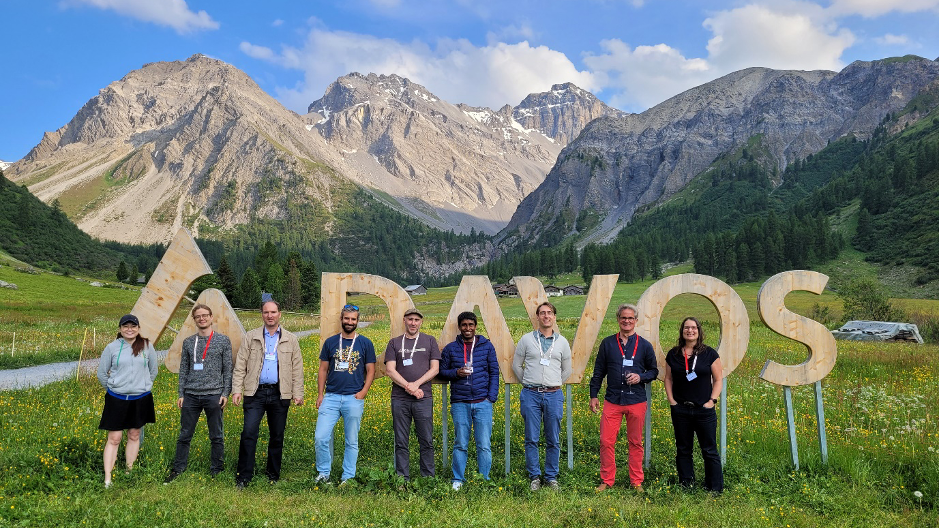
News from the C2SM Community
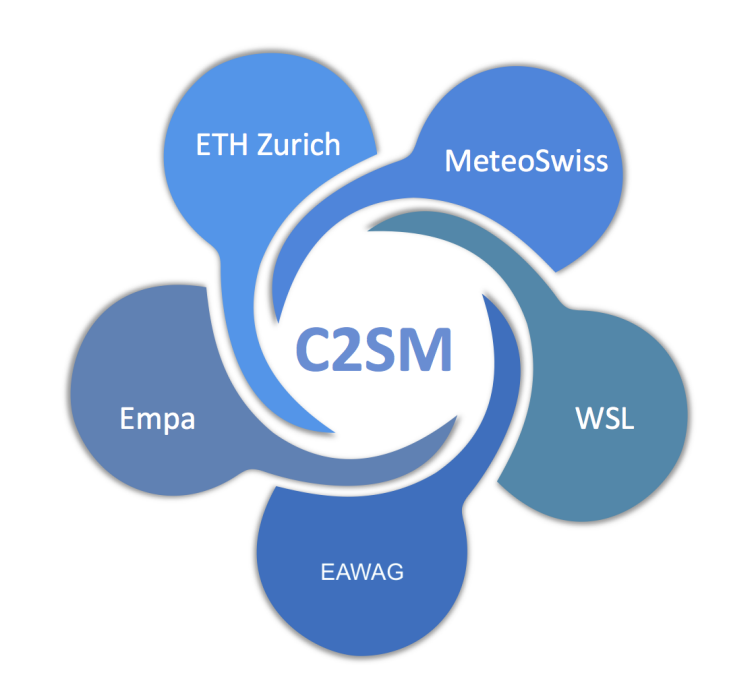
Our congraulations to Sonia Seneviratne for being elected to the Bureau of the Intergovernmental Panel on Climate Change (IPCC). Sonia Seneviratne will represent Switzerland in the Bureau of the Intergovernmental Panel on Climate Change (IPCC). The IPCC Bureau is responsible for advising the panel on science and work strategy and governs the preparation of the IPCC reports. The Intergovernmental Panel on Climate Change is made up of 195 governments and its reports are considered the gold standard of decision-making for climate policy. Sonia Seneviratne, Professor of Land-Climate Dynamics at ETH Zurich, has been elected as Vice-Chair of the Working Group I of the Intergovernmental Panel on Climate Change (IPCC) on 27 July 2023. This working group assesses the physical science of global and regional climate change. The IPCC Bureau is elected for an assessment cycle of 5-7 years. The Swiss candidate Sonia Seneviratne will be part of the IPCC Bureau for the seventh cycle (2023-2030). Her election ensures the representation of ETH Zurich and Switzerland on the IPCC Bureau after the term of Prof. em. Andreas Fischlin as Vice-Chair of IPCC Working Group II in the last IPCC cycle (2015-2023). Congratulations!
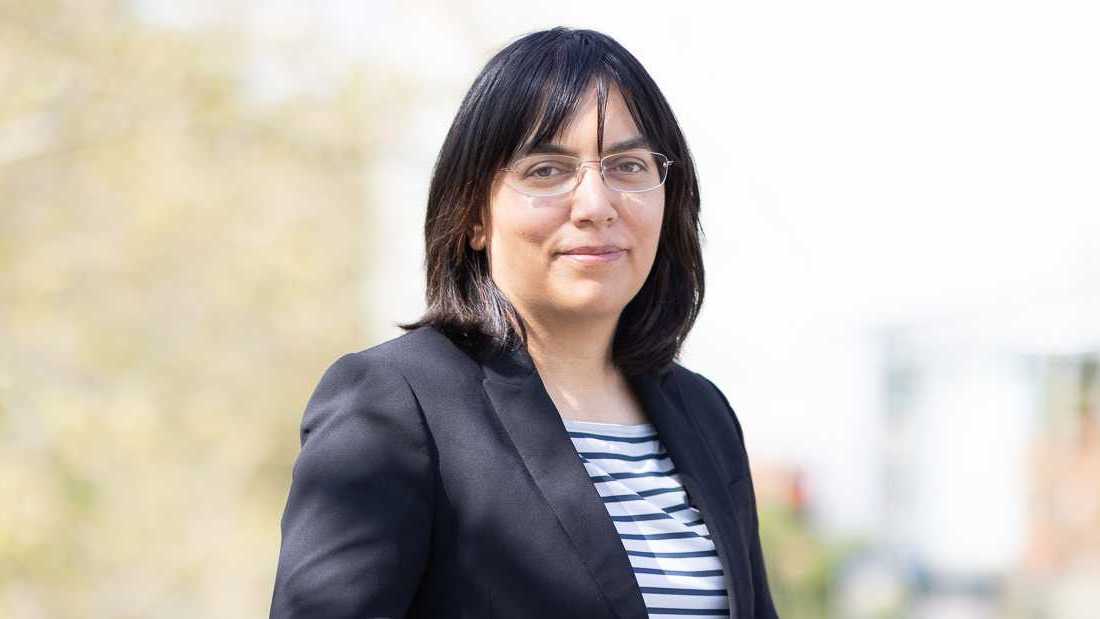
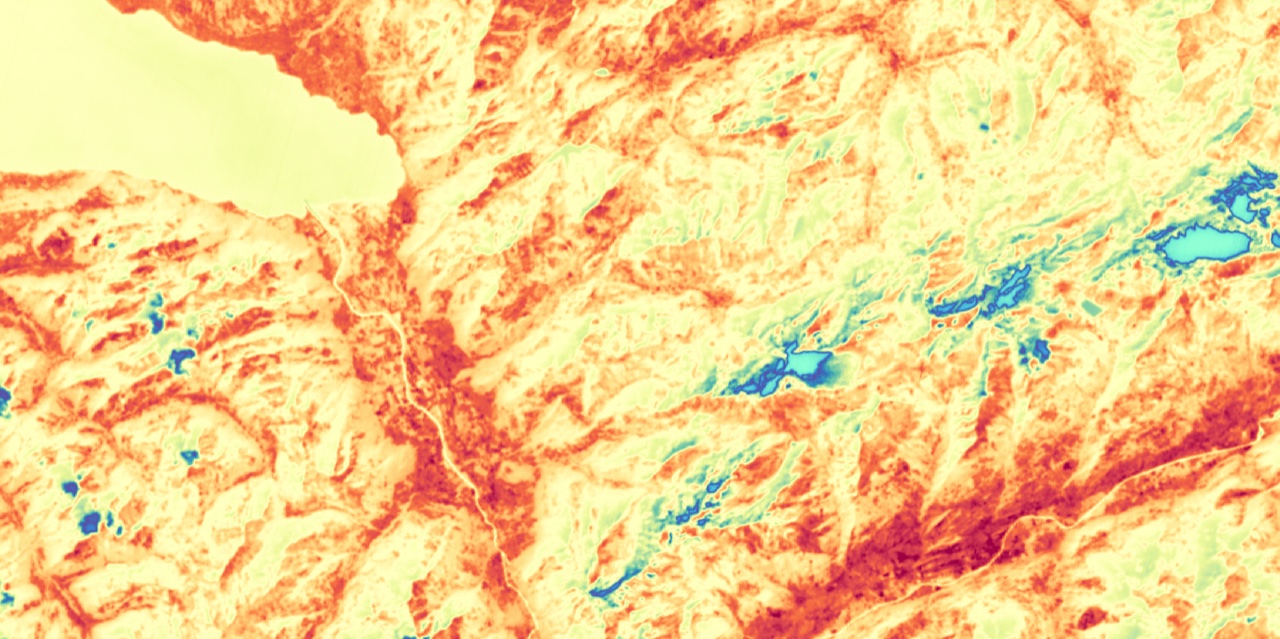
National drought monitoring system – project started at MeteoSwiss
In cooperation with the Federal Office for the Environment (FOEN) and swisstopo, MeteoSwiss has started to develop a national monitoring, early detection, and warning system for drought, which is scheduled to go into operation on January 1, 2025 ) or Simone Bircher ().
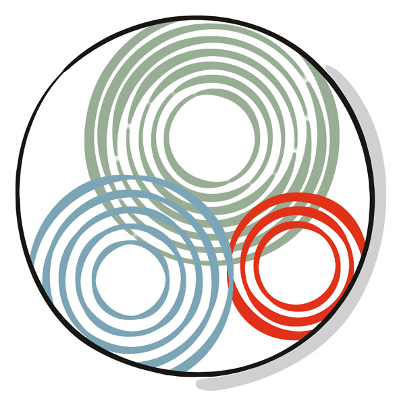
NCCS-Impacts: programme kickoff
In the NCCS programme «Decision Support for Dealing with Climate Change in Switzerland: a cross-sectoral approach» («NCCS-Impacts»), actionable climate services for the environment, economy and society will be developed. Until 2025, several cross-sectoral and interlinked projects will be implemented, addressing the following topics in the context of climate change: global impacts, ecosystem services, human health and animal health, costs of climate change, socio-economic scenarios, and critical energy infrastructures. Fourteen private-sector and research organisations are currently involved in implementing the projects of NCCS-Impacts. On 5 June 2023, they gathered for the official programme kick-off, laying the foundations for future exchanges.
external pagewww.nccs.admin.ch/impacts-encall_made

New European project funded about tipping points in Earth System Models – TipESM
TipESM is a Horizon Europe project funded by the European Commission and SERI with > 7.5 Mio EUR. TipESM brings together scientists from a range of disciplines to deliver a step change in our understanding of climate tipping points in the Earth system, including their impact on ecosystems and society. The project assembles the latest Earth System Models (ESMs) and will design and realise a common ESM experiment protocol that will facilitate analysis of the likelihood of occurrence, and potential reversibility, of tipping points in relation to global warming. These experiments, will be combined with impact models, designed to investigate interactions and feedbacks across the Earth system. Based on the TipESM experiments, existing simulations and observations, the project will investigate the processes leading to tipping points and will search for potential early warning signals and cascading effects across the climate system, down to ecosystems and society.
The TipESM consortium consist of 15 partners across Europe, with the WSL being in charge of tipping points related to terrestrial biodiversity.
Contact person: Dirk Nikolaus Karger,
The external pageHEATawarecall_made project ("Extended-range warnings for heatwaves in Switzerland") aims to assess the potential of heatwave prediction and warnings for Switzerland on timescales up to several weeks, including an evaluation of the potential benefits of such warnings for sectors that are directly linked to human lives and livelihoods. This transdisciplinary project is funded by the external pageCROSScall_made fund (theme: crisis) and external pageMeteoSwisscall_made, and connects several institutions in the areas of sub-seasonal prediction, human health in terms of heat-related mortality and morbidity, and alpine cryospheric hazards in terms of rockfalls and glacier break-offs.
The project is led by external pageDaniela Domeisencall_made (Unil, ETHZ) and external pageMichael Lehningcall_made (SLF, EPFL) as the Co-PIs. Maria Pyrina (Unil, ETHZ) and Dominik Büeler (ETHZ/C2SM, EPFL) are the postdoctoral scientists primarily working on the project in close collaboration with Adel Imamovic, Mark Liniger, Lionel Moret, and Christoph Spirig from external pageMeteoSwisscall_made, Ana Maria Vicedo Cabrera and Sidhart Sivaraj from external pageUniversity of Berncall_made, external pageElizaveta Sharaborovacall_made from EPFL, and external pageValérie Chavezcall_made from Unil.
In preliminary results, a case study for the Canton of Zurich during the hot summer 2022 shows predictability of individual peaks of heat-related mortality up to 2 weeks ahead and indications of longer-lasting phases of excess mortality even up to 4 weeks ahead. In another sub-project we use external pageSNOWPACKcall_made, a model originally developed by SLF for operational avalanche forecasting, to study how atmospheric heatwaves penetrate into alpine rock and influence permafrost.
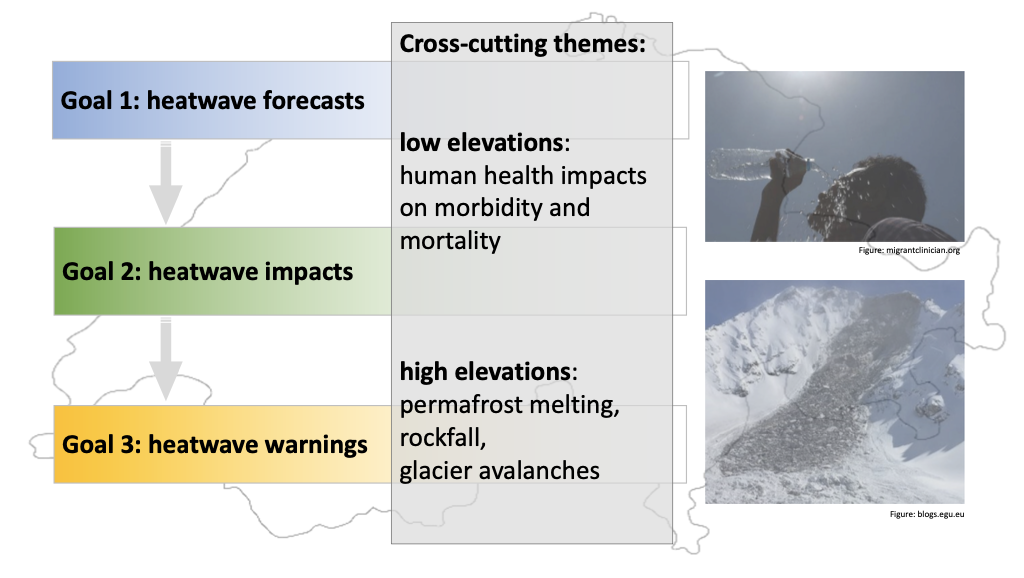
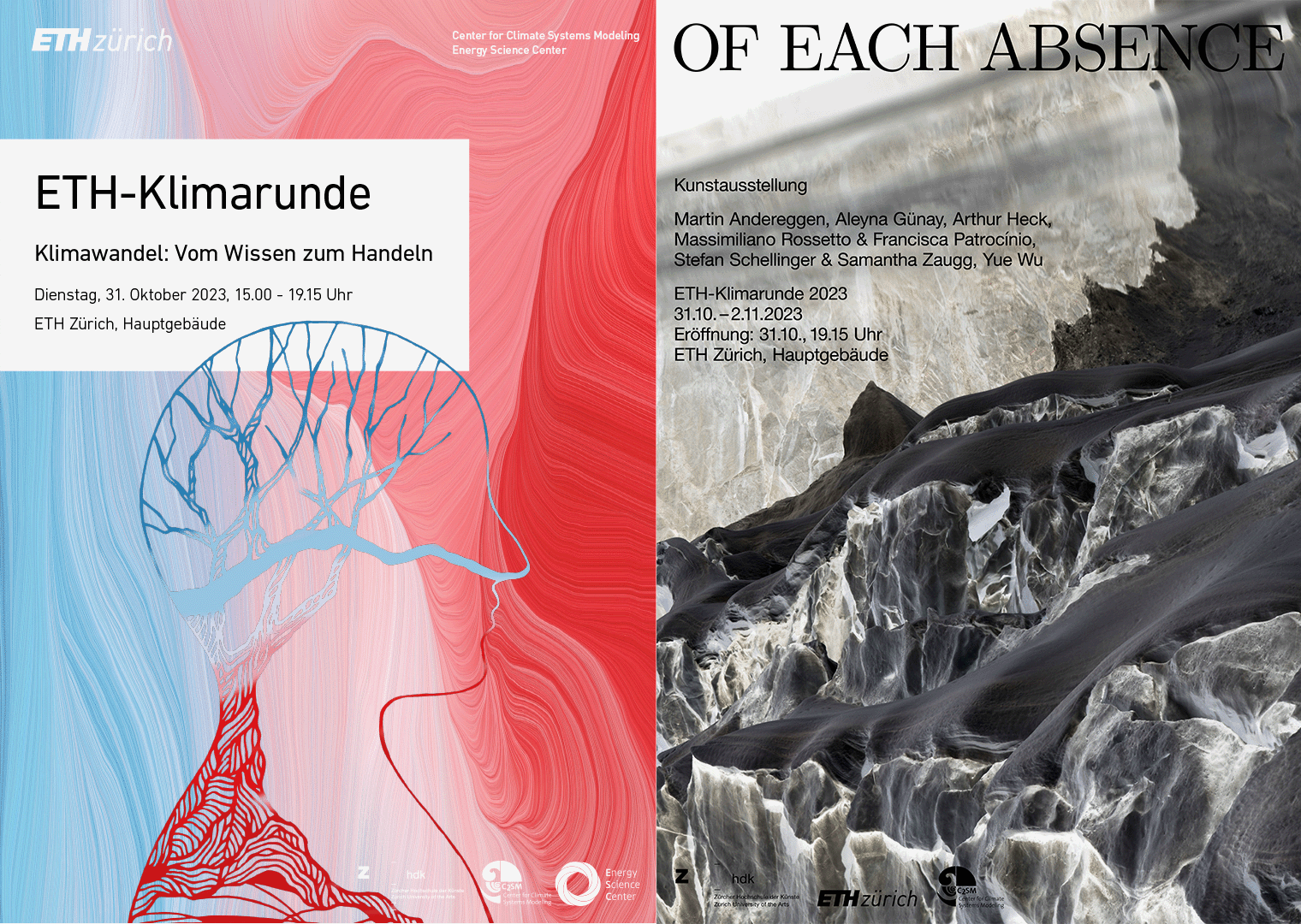
Programm ETH-Klimarunde
- Tischgespräche 15.00 - 16.45 Uhr
- Vorträge inklusive Podiumsdiskussion 17.00 Uhr bis 19.15 Uhr
Kunstausstellung "Of Each Absence"
31.10. - 2.11.2023
- Eröffnung Kunstausstellung im Anschluss an die ETH-Klimarunde am Dienstag, 31. Oktober 2023 um 19.15 Uhr
- Art Walkmit Künstlerinnen und Künstlern zum Abschluss der Kunstausstellung, am Donnerstag, 2. November 2023, von 18:00 bis 19:30 Uhr
Mehr Informationen und online Anmeldung auf der C2SM-Webseite.
We congratulate our community members for their successfully completed PhDs!

- Lukas Jansing: A Lagrangian perspective on the Alpine Foehn, Diss ETH No 29161, defended 15 March 2023
- Katharina Hartmuth: Arctic extreme seasons in a changing climate. Diss ETH No 29419, defended 21 June 2023
- Mauro Hermann: A seasonal weather perspective on forest vitality, vapor pressure deficit, and Greenland melt in a warming climate, Diss ETH No 29541, defended 16 August 2023
Selected Press Articles

- external pageHat die Wissenschaft den Klimawandel unterschätzt?call_made
Radio SRF 1, Echo der Zeit, Prof. Erich Fischer, 01.09.2023 - external pageSchweizer Gletscher im 2022 um sechs Prozent geschrumpftcall_made, external pagejungfrauzeitung.chcall_made
Prof. Daniel Farinotti ,29.08.202 - external pageIn der Schweiz herrscht ein Solaranlagenboom - gefördert vom Bundcall_made
SRF 1, Tagesschau Hauptausgabe, Prof. Tobias Schmidt, 31.08.2023 - external pageEine dritte Parlamentskammer gegen politische Blockadencall_made
NZZ am Sonntag, Prof. Sonia Seneviratne, 27.08.2023 - external pageWorst-Case-Hitzewellen besser vorhersehencall_made
Radio SRF 1, Echo der Zeit, Prof. Erich Fischer, 22.08.2023 - external pageAutobatterien: Europa plant über 50 «Gigafactories»call_made
SRF 1, 10 vor 10, Prof. Tobias Schmidt, 14.08.2023
Highlighted Papers from the C2SM Community

Warm Conveyor Belts in Present-Day and Future Climate Simulations
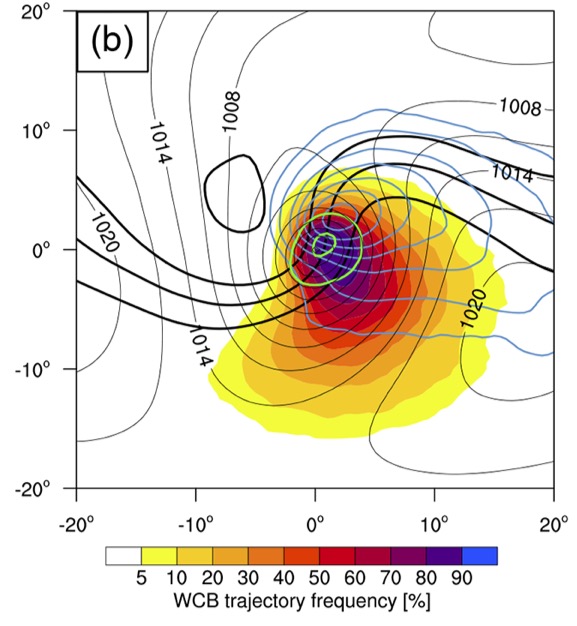
This two-part study is the first that explicitly identified warm conveyor belts, based on trajectory calculations, in global climate simulations. Warm conveyor belts are moist ascending airstreams in extratropical cyclones that lead to intense precipitation and strongly influence Rossby wave dynamics. Thanks to the cooperation with colleagues from Reto Knutti’s group, 3-dimensional wind fields at 6-hourly resolution were available from 50 years of CESM1 simulations both for the present-day and future climate (under the RCP8.5 scenario) to calculate the trajectories. The first part shows that WCBs are represented reasonably well in CESM1 in terms of location and occurrence frequency compared to ERA-Interim. In a future climate, important changes are found in the characteristics of WCBs. The increase in inflow moisture (up to 30% in certain regions and seasons) leads to (i) an increase in WCB-related precipitation, (ii) a strong increase in diabatic heating in the mid-troposphere, and (iii) a higher outflow level, which favours WCBs more strongly interacting with the upper-level Rossby waveguide. Part 2 the considers the effect of this increasing WCB intensity in the future climate on the associated cyclones and shows that WCB-related PV production will be even more important for explosive cyclone intensification than in the present-day climate.
Joos, H., M. Sprenger, H. Binder, U. Beyerle, and H. Wernli (2023): Warm conveyor belts in present-day and future climate simulations – Part 1: Climatology and impacts, Weather Clim. Dynam., 4, 133-155, external pagehttps://doi.org/10.5194/wcd-4-133-2023call_made
Binder, H., H. Joos, M. Sprenger, and H. Wernli (2023): Warm conveyor belts in present-day and future climate simulations – Part 2: Role of potential vorticity production for cyclone intensification, Weather Clim. Dynam., 4, 19-37, external pagehttps://doi.org/10.5194/wcd-4-19-2023call_made
The Pseudo-Global-Warming (PGW) Approach: Methodology, Software Package PGW4ERA5 v1.1, Validation and Sensitivity Analyse
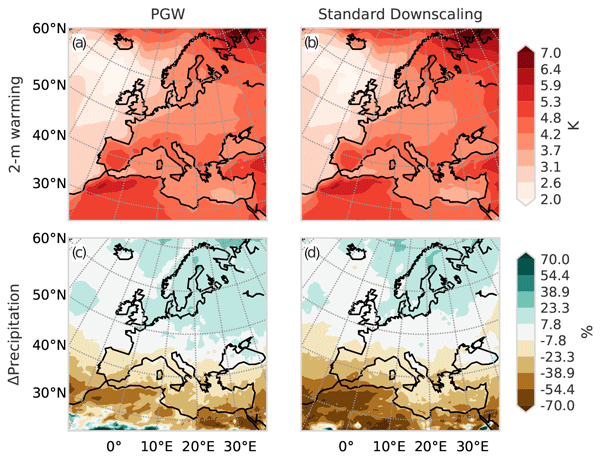
The term “pseudo-global warming” (PGW) refers to a simulation strategy in regional climate modeling. The strategy consists of directly imposing large-scale changes in the climate system on a control regional climate simulation (usually representing current conditions) by modifying the boundary conditions. This differs from the traditional dynamic downscaling technique where output from a global climate model (GCM) is used to drive regional climate models (RCMs). The PGW climate changes are usually derived from a transient global climate model (GCM) simulation. The PGW approach offers several benefits, such as lowering computational requirements, flexibility in the simulation design, and avoiding biases from global climate models. However, implementing a PGW simulation is non-trivial, and care must be taken not to deteriorate the physics of the regional climate model when modifying the boundary conditions. To simplify the preparation of PGW simulations, we present a detailed description of the methodology and provide the companion software PGW4ERA5 facilitating the preparation of PGW simulations. In describing the methodology, particular attention is devoted to the adjustment of the pressure and geopotential fields. Such an adjustment is required when ensuring consistency between thermodynamical (temperature and humidity) changes on the one hand and dynamical changes on the other hand. It is demonstrated that this adjustment is important in the extratropics and highly essential in tropical and subtropical regions. We show that climate projections of PGW simulations prepared using the presented methodology are closely comparable to traditional dynamic downscaling for most climatological variables.
Brogli, R., Heim, C., Mensch, J., Sørland, S. L., and Schär, C.: The pseudo-global-warming (PGW) approach: methodology, software package PGW4ERA5 v1.1, validation, and sensitivity analyses, Geosci. Model Dev., 16, 907–926, external pagehttps://doi.org/10.5194/gmd-16-907-2023call_made
Jet Stream Dynamics from a Potential Vorticity Gradient Perspective: The Method and its Application to a Kilometre-Scale Simulation
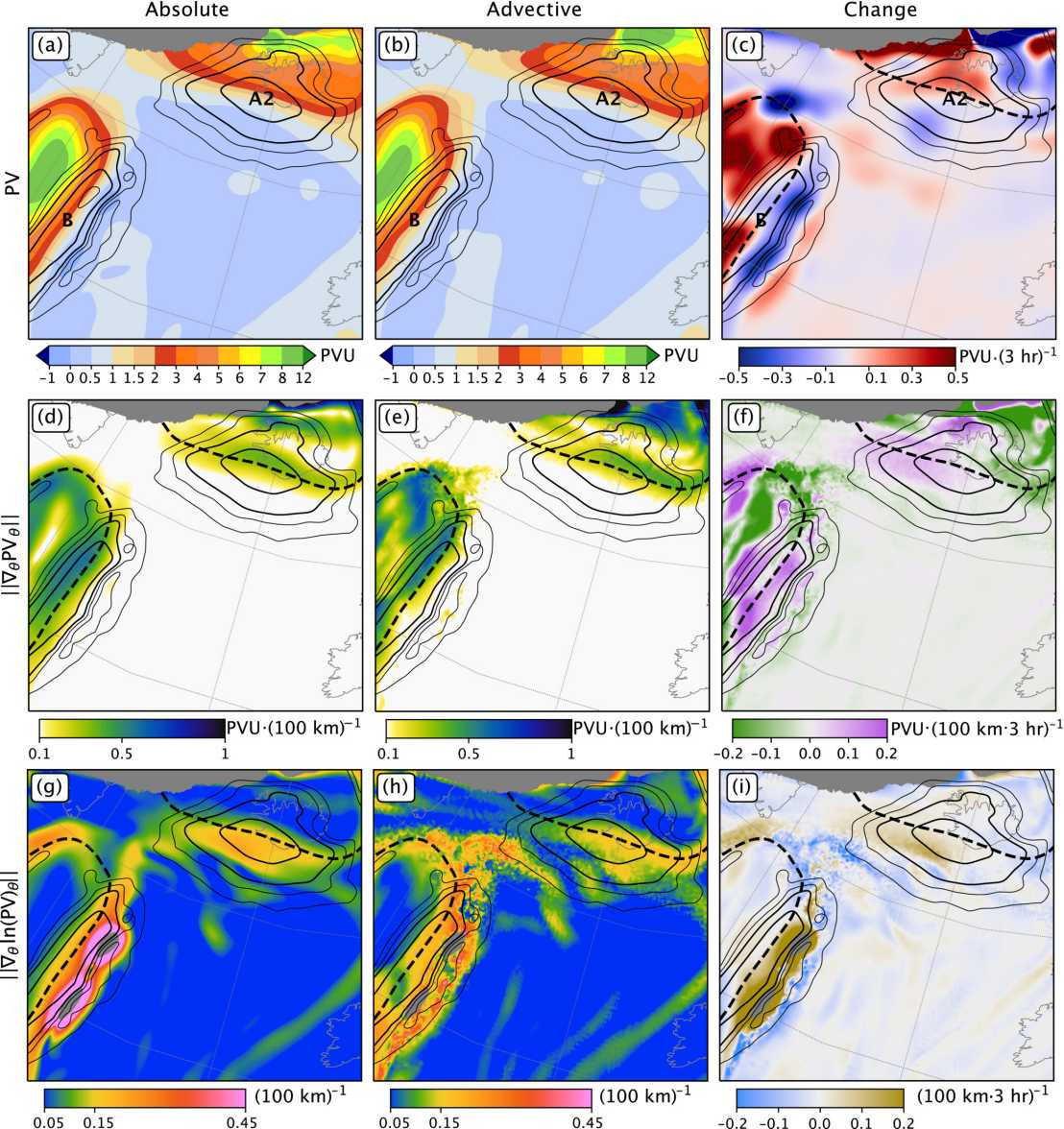
The influence of adiabatic and diabatic processes on the midlatitude circulation is a formidable research question, especially considering their projected changes under global warming. This study presents the prospects, merits, and caveats of a potential vorticity (PV) gradient perspective as a means to disentangle the contributions of adiabatic and diabatic processes affecting the midlatitude circulation. Theoretical considerations reassess the link between the PV gradient and the jet stream. They reveal that the maximum isentropic PV gradient is consistently located on the stratospheric side of the jet, whereas the gradient of is shifted to the tropospheric side but, in general, is better aligned with the jet axis. The stratospheric shift of the PV gradient results from variations in stability across the tropopause, whereas the tropospheric shift of the gradient results from variations in vorticity. Regions of high PV gradient may serve as a proxy for the curvature of the wind field in the case of sufficiently small variations in stability. Otherwise, they depict variations in both wind and thermal stratification along tropopause-intersecting isentropic surfaces. Lagrangian “PV gradient thinking” is demonstrated in two case studies of jet streak evolution in a simulation with 1.1 km grid spacing performed with the graphics-processing-unit-enabled numerical weather prediction model Consortium for Small-Scale Modelling featuring on-line air parcel trajectories. Dry deformation drives the Lagrangian evolution of the PV gradient in the first case, whereas there is a pronounced influence of diabatic modification in the second case. The Lagrangian PV gradient perspective presented offers fresh insight into adiabatic and diabatic processes underlying the midlatitude circulation variability and change.
Bukenberger, M., Rüdisühli, S. & Schemm, S.(2023) Jet stream dynamics from a potential vorticity gradient perspective: The method and its application to a kilometre-scale simulation. Quarterly Journal of the Royal Meteorological Society, 149(755, 2409–2432. Available from: external pagehttps://doi.org/10.1002/qj.4513call_made
Daily 1 KM Meteorological Forcing Data for Climate Impact Studies
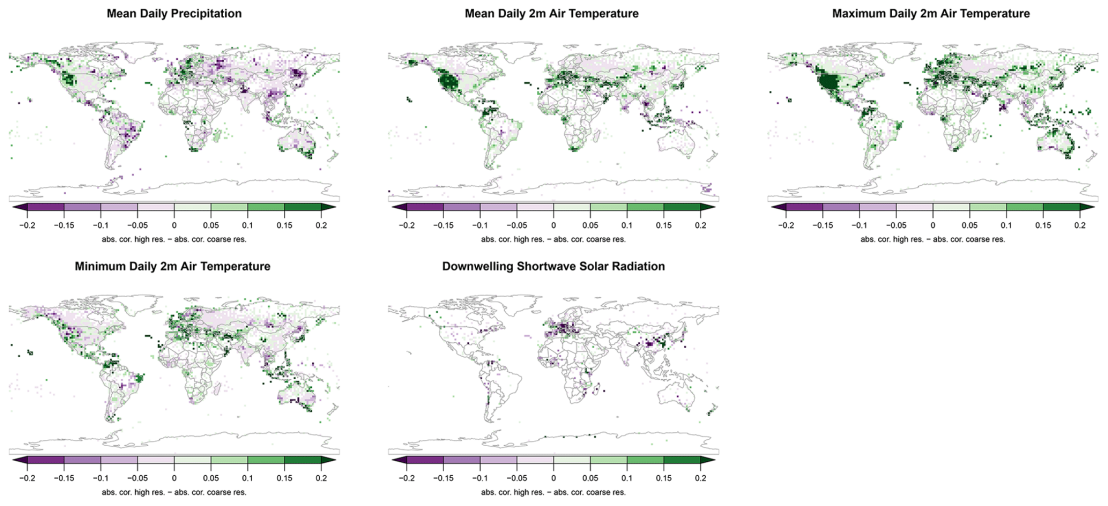
Many impacts of climate change happen at high spatio-temporal resolutions that are not covered by current global climate datasets. Here we present CHELSA-W5E5, a climate forcing dataset at daily temporal resolution and 30 arcsec spatial resolution for air temperatures, precipitation rates, and downwelling shortwave solar radiation. This dataset is a spatially downscaled version of the 0.5∘ W5E5 dataset using the CHELSA V2 topographic downscaling algorithm. The downscaling generally increases the accuracy of climate data by decreasing the bias and increasing the correlation with measurements from meteorological stations. The topographically downscaled climate data compares well with a dynamical downscaling using a regional climate model, as time series from both sources are similarly well correlated to station observations. This is remarkable given the lower computational cost of the CHELSA V2 algorithm compared to WRF and similar models. The dataset can be downloaded using the ISIMIP data portal: external pagehttps://doi.org/10.48364/ISIMIP.836809.3call_made
Karger, D.N., Lange, S., Hari, C., Reyer, C.O.P., Conrad, O., Zimmermann, N.E., Frieler, K. (2023) CHELSA-W5E5: Daily 1 km meteorological forcing data for climate impact studies. Earth System Science Data. external pagehttps://doi.org/10.5194/essd-15-2445-2023call_made
On the Statistical Distribution of Temperature and the Classification of Extreme Events Considering Season and Climate Change – an Application in Switzerland
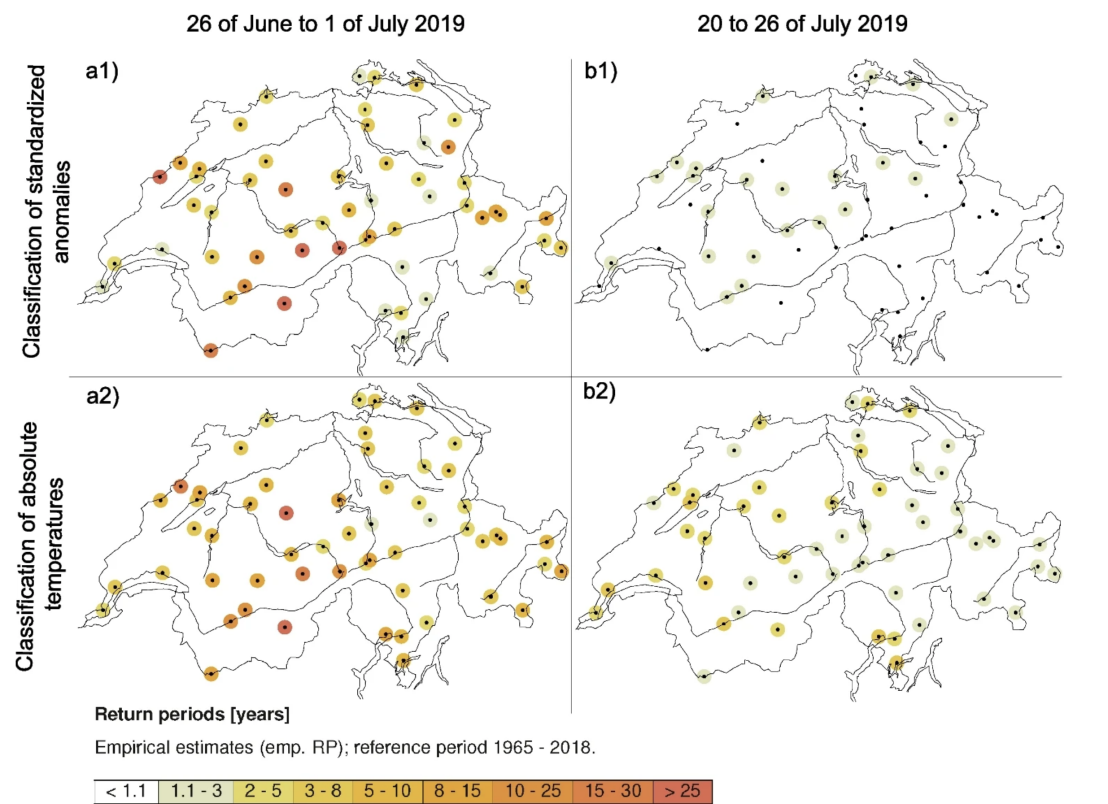
With the increased occurrence of hot spells in recent years, there is growing interest in quantifying the recurrence of extreme temperature events. However, pronounced temperature anomalies occur all year round, and a reliable classification in terms of the time of occurrence in the year is needed. We present a novel approach to classifying daily air temperatures that take into account the seasonal cycle and climate change. We model the distribution of the daily Swiss temperatures using the skewed generalised error distribution with four time-varying parameters, thereby accounting for non-Gaussianity in daily air temperature, while the climatic trend is modeled linearly with smoothed northern hemisphere temperature as an explanatory variable. The approach is suitable to classify historical and current extreme temperatures with respect to the temperature range expected at the time of the event and offers new possibilities to analyse daily air temperature.
Gubler, S., Fukutome, S., and Scherrer, S.C. (2023) On the statistical distribution of temperature and the classification of extreme events considering season and climate change – an application in Switzerland. Theor. Appl. Climatol., 153, 1273–1291, external pagehttps://doi.org/10.1007/s00704-023-04530-0call_made


